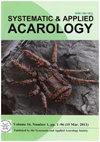丹贝三角藻(Eubelba danubedeltaica sp.nov.)的形态个体发生(Acari,Oribatida,Damaidae)
IF 1.2
3区 农林科学
Q2 ENTOMOLOGY
引用次数: 0
摘要
摘要描述和说明了丹贝三角洲Eubelba danubedeltica sp.nov.的形态个体发生。达那贝三角洲E.danubedeltaica的成虫与雕刻的达那贝最相似(Mihelčič,1957),雕刻的达那贝三角洲E.不同之处在于存在结节E2p、稍长的刚毛c1和腿IV,以及较厚且明显有倒钩的表浅、生殖器、生殖器和肛门刚毛,除了在高SEM放大倍数下清晰可见的细刺生殖器和肛门刚毛。在达那贝三角洲E.danubedeltaica的幼虫中,除了若虫中的短刚毛和非常长的刚毛状两端刚毛外,大多数前刚毛都是中等大小的,它们在远端强烈弯曲。除了幼虫中的中型c3、la、lm和h2,以及若虫中的中型t3和p2外,大多数幼体的胃刚毛都很长或很长。若虫是四缺型和真皮层的,即它们失去了d系列刚毛,并使用位于刚毛对h3之间的角状突起携带前几龄的蜕皮头皮。在所有青少年中,跗骨I上的发丝ε是凹陷的,但在成年时是突起的。Seta d在膝I–III上伴随solenidionσ,在胫骨II–IV上伴随φ。本文章由计算机程序翻译,如有差异,请以英文原文为准。
Morphological ontogeny of Eubelba danubedeltaica sp. nov. (Acari, Oribatida, Damaeidae) and comments on Eubelba Miko
Abstract The morphological ontogeny of Eubelba danubedeltaica sp. nov. is described and illustrated. The adult of E. danubedeltaica is most similar to E. sculpta (Mihelčič, 1957) which differs from E. danubedeltaica by the presence of tubercle E2p, slightly longer seta c1 and leg IV, and thicker and clearly barbed epimeral, genital, aggenital and anal setae whereas in E. danubedeltaica tubercle E2p is absent and these setae are thinner and most are smooth, except for finely barbed genital and anal setae that are clearly visible at a high SEM magnification. In the juveniles of E. danubedeltaica, most prodorsal setae are of medium size, except for short seta in in the nymphs and very long setiform bothridial seta which are strongly curved in the distal part. Most gastronotal setae of juveniles are long, or very long, except for medium-sized c3, la, lm and h2, and short h3 in the larva, and medium-sized c3 and p2 in nymphs. The nymphs are quadrideficient and eupheredermous, i.e. they have lost the d-series setae and carry the exuvial scalps of previous instars using a cornicle located between setal pair h3. In all juveniles, the famulus ε on tarsus I is sunken but is emergent in the adult. Seta d accompanies solenidion σ on genua I–III and φ on tibiae II–IV.
求助全文
通过发布文献求助,成功后即可免费获取论文全文。
去求助
来源期刊

Systematic and Applied Acarology
ENTOMOLOGY-
CiteScore
2.20
自引率
33.30%
发文量
152
期刊介绍:
Systematic and Applied Acarology (SAA) is an international journal of the Systematic and Applied Acarology Society (SAAS). The journal is intended as a publication outlet for all acarologists in the world.
There is no page charge for publishing in SAA. If the authors have funds to publish, they can pay US$20 per page to enable their papers published for open access.
SAA publishes papers reporting results of original research on any aspects of mites and ticks. Due to the recent increase in submissions, SAA editors will be more selective in manuscript evaluation: (1) encouraging more high quality non-taxonomic papers to address the balance between taxonomic and non-taxonomic papers, and (2) discouraging single species description (see new special issues for single new species description) while giving priority to high quality systematic papers on comparative treatments and revisions of multiple taxa. In addition to review papers and research articles (over 4 printed pages), we welcome short correspondence (up to 4 printed pages) for condensed version of short papers, comments on other papers, data papers (with one table or figure) and short reviews or opinion pieces. The correspondence format will save space by omitting the abstract, key words, and major headings such as Introduction.
 求助内容:
求助内容: 应助结果提醒方式:
应助结果提醒方式:


